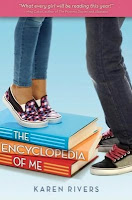Written by
Megan Crewe
Hyperion Disney Group
978-1-4231-4616-2
308 pp.
Ages 12+
2011
There are many ways to fall. You can fall down, fall in love, fall apart, fall asleep, fall at someone's feet, fall back, fall away, fall behind, fall flat on your face, fall short, fall afoul. And in
Megan Crewe's first book in her YA
Fallen World Trilogy, The Way We Fall, someone at sometime has demonstrated each type of falling. On an island that succumbs to the wrath of an infectious virus, "falling" becomes the norm.
Through the journal entries of sixteen-year-old Kaelyn, ostensibly to her former best friend Leo who is going to school off the island, the reader is taken on a harrowing trek from health to illness to fear and death, with valiant efforts throughout to manage, if not eradicate, a contagion. When the infection first hits, it is hard to differentiate it from a
cold, with the typical coughing and sneezing. However, when relentless
scratching is evident, followed by displays of extreme expression of
affection, distrust and hysteria, coupled with delusions, hospitalization is required. As the microbiologist on the island, Kaelyn's father becomes a central figure in the investigation of the virus, and Kaelyn, her older brother Drew, and Mom, an islander who manages the local café at the local service station, are among the first to wear masks and keep themselves home to avoid contact with others.
With the spread of the illness and deaths recorded from it, some islanders find their way off the island, though some, like Kaelyn's Uncle Emmett and her seven-year-old cousin, Meredith, are encouraged to wait until the mainland has secured a site to process them. But, when the island is quarantined, the residents become reliant on the mainland government for food and medical and other supplies, a position that many protest, with consequences. The reactions of the islanders as well as the mainlanders, including soldiers sent to offer protection, to the quarantine could warrant a study in fear.
While Kaelyn volunteers to notify residents of the quarantine and help get ill residents to hospital, Leo's girlfriend Tessa is recruited to help grow plants that may offer hope for treatment (a passionate gardener, Tessa has her own greenhouse). A young man, Gav, who'd organized a group of guys into a Fight Club, had them "looting" from the grocery store and storing goods in a warehouse, arranging deliveries to those who couldn't get out, were ill, or had no support systems. Through a series of interactions, including Gav coming by to teach them some self-defense, he and Kaelyn grow closer, offering each other support and affection in a troubling situation.
While I have shared very little about the sequence of events that lead to the story's end, probably because the plot and subplots are complex (but elegant), the reader will not be given much reprise from action and chaos of a community faced with more than a contagion; the mentality of those quarantined presents as much turmoil as the fatal infection itself. The psychological responses of the residents to living with a contagious illness and in a quarantined situation vary from heroic and charitable to egocentric and even mercenary. With a complex menagerie of characters, coupled with
Megan Crewe's plotting and organizational style i.e., Kaelyn's short, dated journal entries addressed to Leo,
The Way We Fall successfully keep readers interested throughout, appropriately earning it a nomination for this year's Forest of Reading
®'s White Pine Award. While the book offers some hope in its conclusion, don't expect everything to be resolved by the time the ferry finally approaches the island again; after all that falling, it will take a lot to help everything right itself ("in love" exempted).
Luckily,
The Lives We Lost, Book 2 in the
Fallen World Trilogy, came out just last month, and the title of the third book,
The World We Make, has been announced for release in the winter of 2014.
Megan Crewe can be assured that this reviewer will be pursuing those titles promptly, determined to learn more about Leo, Drew, Aunt Lillian, the underlying hostility between Drew and Gav, and the only positive fall - Kaelyn and Gav in love.





































